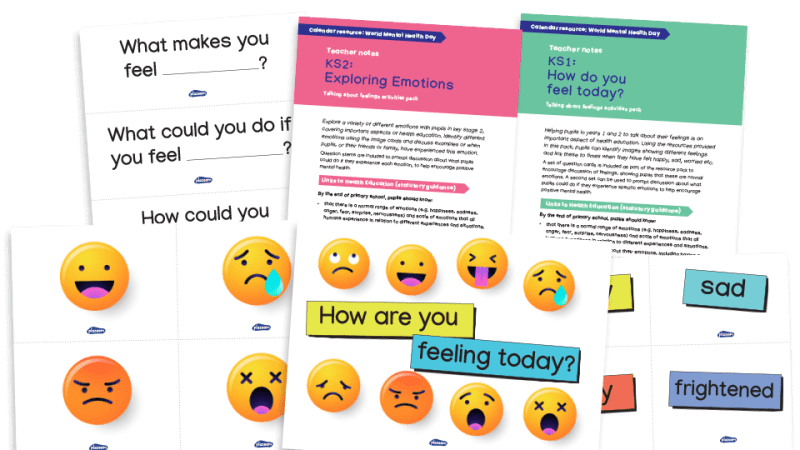World Mental Health Day activities – Best 2025 resources for schools

Raise awareness, help staff and students in need and boost wellbeing in your school this October…

- by Teachwire
- Classroom expertise and free resources for teachers

Use these World Mental Health Day activities and resources to celebrate this important day in your school…
What is World Mental Health Day?
World Mental Health Day’s purpose is to raise awareness of mental health issues around the world and to mobilise efforts in support of mental health.
It’s a day to talk about mental health and what more we need to do to make mental health care a reality for people worldwide. 2025’s theme is yet to be announced, but 2024’s theme was ‘It’s time to prioritise mental health in the workplace‘.
When is World Mental Health Day?
World Mental Health Day is on Friday 10th October 2025.
Other mental health events
Children’s Mental Health Week takes place between 3rd-9th February 2025. Mental Health Awareness Week is between 12th-18th May 2025.
World Mental Health Day resources
Encourage kindness in your class

If you’re looking for World Mental Health Day activities for primary pupils, this free lesson plan from Emily Azouelos explores how children can feel more connected to their peers and community in meaningful, fulfilling ways. It also covers how children can overcome the challenges they may face.
KS1 and KS2 activity packs
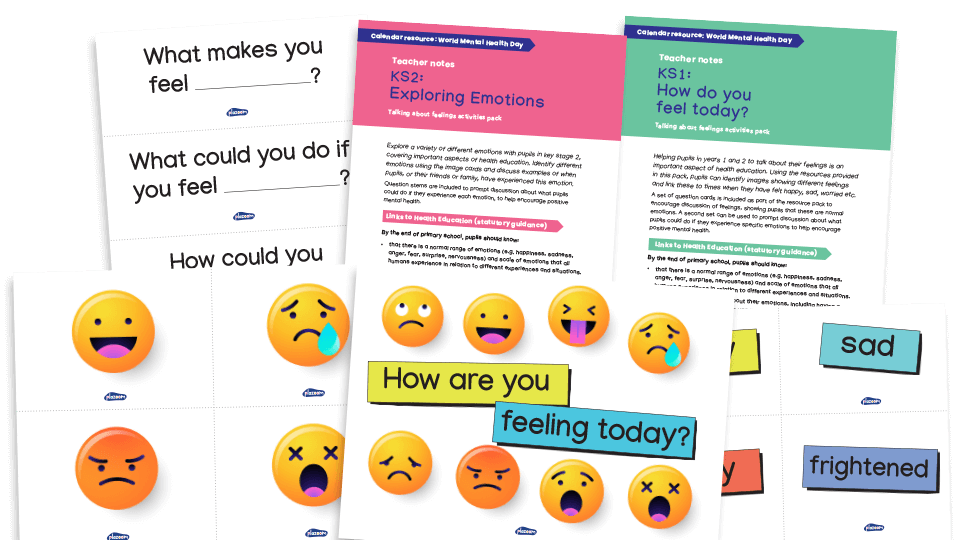
Use these excellent free World Mental Health Day activities from Plazoom to explore a range of different emotions with KS1 or KS2 children.
Pupils will identify different emotions using the image and word cards and discuss examples of when they’ve felt these emotions. Use the question cards and question stems to encourage conversation about positive mental health.
There are activities for both KS1 and KS2, plus teacher guidance about how to use them.
Recharging your mental battery
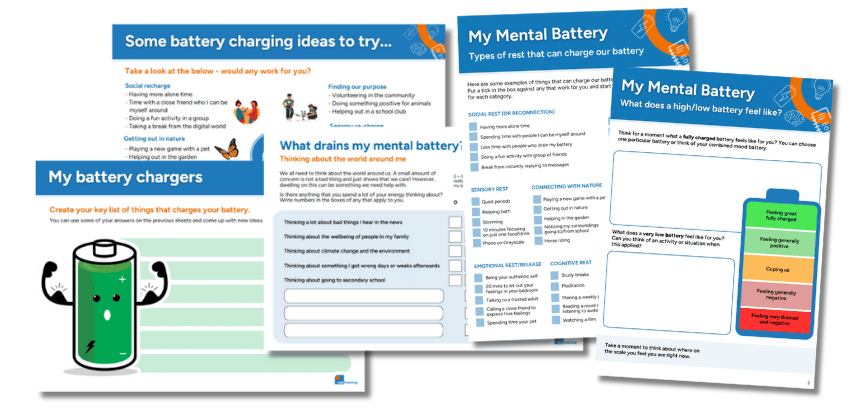
These free mental health worksheets guide children and young people in recognising what impacts their emotional and mental energy, both positively and negatively.
With separate versions for primary (Year 5+) and secondary (Year 8+), they encourage reflection on daily struggles and restorative activities, offering practical ways to support emotional wellbeing.
Mental health activity pack
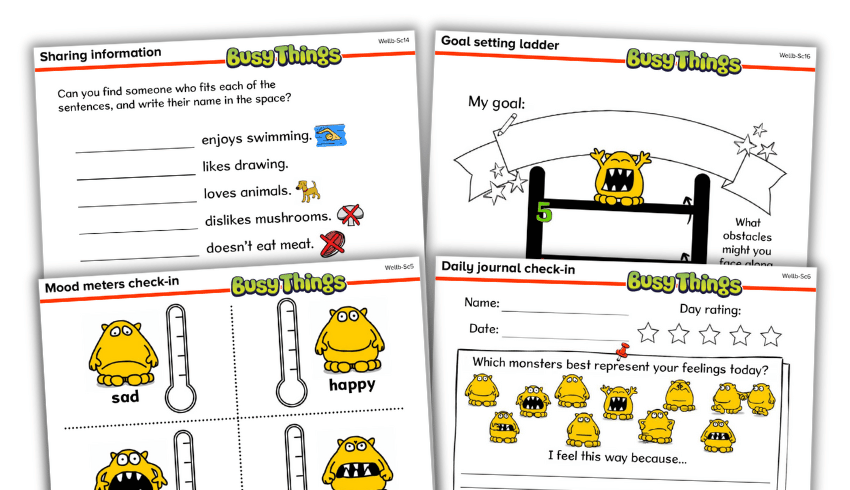
Designed for primary schools, this pack offers practical children’s mental health activities such as ‘5 Ways to Wellbeing,’ mood meters and information-sharing tasks to nurture positive mental health.
Nature lesson plan

Explore emotions and help your pupils build up tools to deal with everyday stressors with this free KS2 wellbeing lesson plan that delves into the themes of nature and wellbeing.
Mental health and wellbeing worksheets
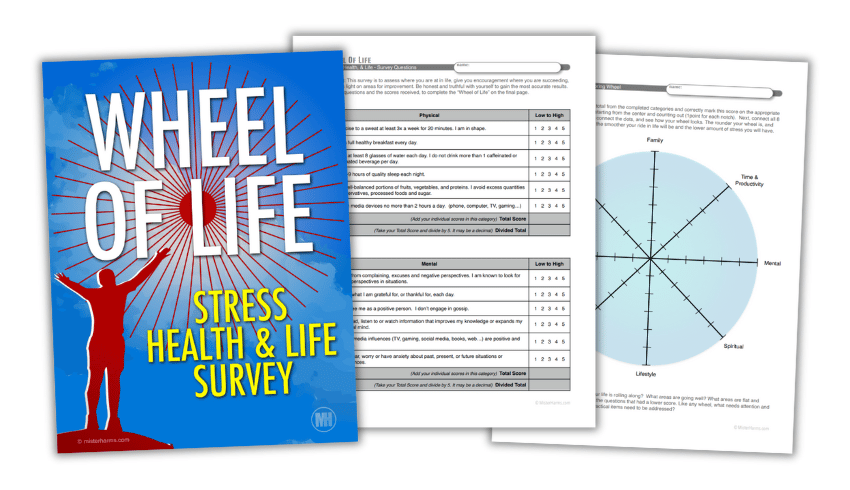
How are your students’ lives rolling along? Which areas are going well and which areas need attention? Find out with this reflective Wheel of Life activity. Download the free worksheets.
Managing feelings: KS1 medium-term plan

This six-week series of World Mental Health Day activities for KS1 focuses on helping pupils to be able to express their feelings and understand that all emotions are equally valid.
There are also accompanying resources to help you deliver the lessons. These include PowerPoints and worksheets.
Explore The Grand Hotel of Feelings

Use The Grand Hotel of Feelings by Lidia Brankovic in KS2 to help pupils investigate their feelings and emotions. It’s a picturebook that names a wide range of emotions and promotes the idea that all emotions are normal and welcome. We’ve got a free PDF full of cross-curricular ideas.
Mental health lead year planner
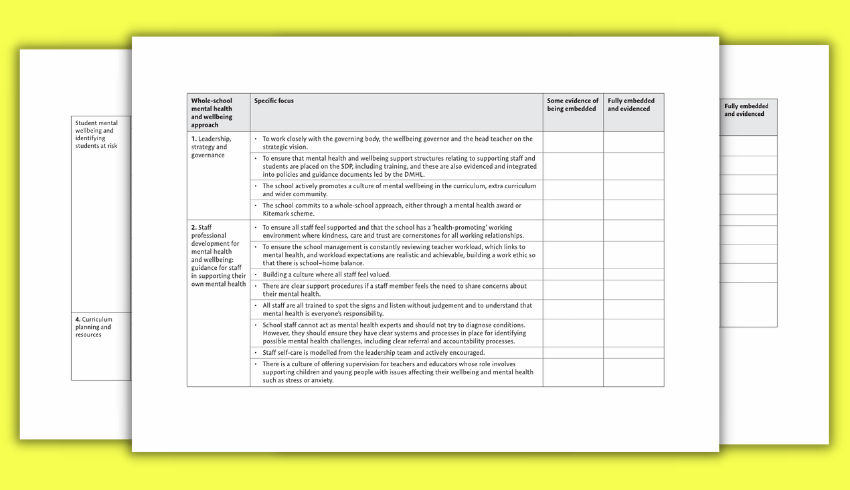
If you are the designated mental health lead for your school, this free, printable year planner will help you organise your tasks and ensure you focus on mental health throughout the whole year, not just during dedicated World Mental Health Day activities.
Movies for mental health

Film is an ideal way to start a conversation about mental health. Into Film has a great selection of titles and resources, all available free to schools with an Into Film Club.
Mental health posters

These free mental health posters focus on self-care and self-respect. Use them in PSHE lessons or as wall displays. There are three PDFs included:
- Self-care guide
- Empowerment and self-respect guide
- Be your own bestie guide
Mental health training

Funded by the Department for Education, and developed in partnership with Real Group, the following units are free to complete and will take around 20 minutes each. Each unit is supported by a live online networking session:
- Creating an emotionally safe environment
- Promoting mental wellbeing in your setting
- Understanding and promoting resilience
- Understanding anxiety and creating a supportive learning environment
Senior mental health lead training

If you work in an eligible state-funded school or college in England, you can receive full funding for this senior mental health lead training from the DfE. The course offers 20 hours of learning with a suggested three-month structure.
7 simple ways to support students’ mental health

There are no magic fix-alls to maintaining good mental health and wellbeing in pupils, and it certainly can’t all be done via a handful of World Mental Health Day activities.
However, these seven cheap and easily implemented practices from teacher and KS4 lead Susan Strachan can really make all the difference…
For teenagers, issues around friendships, hormones, home life, navigating the day to day pressures of growing up and becoming more independent, all while being stuck in a ‘no man’s land’ between childhood and adulthood, can at times seem insurmountable and incredibly difficult.
But as teachers and support staff in school there are several things that we can do to relieve this burden and ensure that the students in our care are supported and listened to.
So, how can we help? These simple, common sense ideas can help to ensure that students who are facing, or have faced, mental health issues have someone they can talk to.
1 Pastoral support
Pastoral support is absolutely key to ensuring that students have access to guidance and support. Having an individual that the student is able to speak to in confidence is essential – whether that’s a tutor, a mentor paid specifically to be a student wellbeing officer, a head of year or deputy head of year, a head of house or a teacher.
It doesn’t matter so much where that pastoral support comes from, as long as students are aware of to whom they need to go in order to get the support and guidance they need and deserve.
2 Time
In schools, time is often pressured and hard to find, but if a student is distressed or upset then the best thing anyone can give is a bit of time to sit down with them and listen.
It’s not always easy in the insanity of a school day when everyone is busy and under pressure. And it can feel frustrating to have to take the time out when your to-do list is lurking ominously in the background.
However, finding a moment to speak to a student who is on the edge is one of the biggest things you can do. And it can really make a difference.
“Finding a moment to speak to a student who is on the edge is one of the biggest things you can do”
3 Know your students
Whether this is in classes, during tutor time, in student support or just from simply from seeing pupils around the school, it’s important to know your students.
Try to see breaktime and lunchtime duties less as a ‘must-do’ inconvenience, and more of an opportunity to get to know the students a little better.
If you have a designated area you will quickly know who ‘hangs around’ in that spot, and it creates the perfect opportunity to have a chat and find out more about these particular pupils.
In tutor time, greet the students by name every day and make an effort to ask them on a Monday what they got up to at the weekend or holidays. These dialogues aren’t time consuming and they make everyone’s day a little bit nicer.
I know that from these conversations I can ascertain whether a student has had a good or bad weekend and if they are likely to need a little pep talk or a reminder that they can pop and see me if they need to. Or, as happens more often, reminding them that they can have a chat with me in tutor time to let me know what’s on their mind.
In class, speak to the students when appropriate. I teach English, which lends itself to asking students what they enjoy and why when they’re doing speeches or other written work, or what makes them really angry or upset. And this can be a good way to understand where they are coming from.
4 Notice
This links in really nicely to knowing your students. Have you spotted a drop in output from a previously conscientious student? Have you noticed a change in their demeanour, or spotted an aura of unhappiness about them?
Are you aware of something that has happened in a pupil’s life that could potentially make them feel upset, depressed, uncertain? Or is there a sense that something has changed or is different?
As I mentioned above, it’s important that you know your students pretty well in order to notice these changes. But if you do spot something that strikes you as unusual, a quick conversation to ‘check in’ can be transformative.
The student may or may not open up to you, but they will know that someone cares, and that can have a catalytic effect.
This could mean that they then speak to friends or family, because they know that someone has seen that something is not quite right with them. I know from experience that this does happen, and it does help.
Trending
5 Counselling
Have an on-site professional counsellor to help students who have complex issues and problems with which they are finding it difficult to cope.
There are certain circumstances that students have to deal with that should, or even must, involve other people, and a counsellor is a good professional way to go about getting these more-complex issues dealt with.
6 Multi-agency cooperation
On a wider scale, schools should make sure that they are open and honest and communicate effectively with the other professionals who can help students.
There are organisations (again, that are also stretched for capacity) to which students could and should be referred. By ensuring that we communicate effectively as a school we can help students together.
7 Communicate internally
Make sure that information about a student is communicated as and when it is relevant, and to whom it is relevant.
This can be a note in the system on a student’s file that goes to all members of staff who have contact with that student. This means that all relevant people are informed, and are therefore able to support them appropriately.
How SLTs can support teacher mental health

Teacher and mental health first aider Amy Sayer looks at how senior leadership teams can contribute towards a healthier wellbeing climate in their schools…
Conversations around mental health can be awkward and hard. This is due, in part, to a lack of training in schools about how to have them.
When staff are absent due their mental ill health, it is rarely an isolated absence. There may have been numerous short-term absences for ‘migraines’ or ‘stomach issues’.
They may have exhibited changes in their behaviour. Other staff might have disregarded these as the usual stresses and strains of school life.
Those colleagues working closely alongside them may have noticed these changes over a long period of time, but not known how to discuss their concerns. In some cases, these colleagues may have worried that doing so might make the situation worse, and cause further absence.
Change of perspective
In order to look after staff mental health in schools, all leaders should be confident in doing the following:
- Identifying the signs and symptoms of poor mental health
- Having timely and appropriate conversations with staff, to support them in looking after their mental health
- Creating a culture where everyone has a safe space in which to talk about their individual mental health needs
Investing time and support in staff should be a key component of all leadership roles within a school. School staff are under increasing pressure to spin ever more plates. And this is in an environment where budget cuts have led to ever increasing workloads.
This can often lead to staff having less time to invest in important self-care, which can act as a protective factor against mental ill health.
Supportive leaders
Some staff will be aware of their struggles with their mental health, and may be receiving treatment through their GP or other support services such as the Education Support Partnership.
They may, however, feel ashamed of this, and that they can’t make their voices heard. This can make things worse. Having a range of supportive leaders in a school who can be trusted and genuinely care about their staff can make a huge difference.
Teacher burnout self-evaluation worksheet
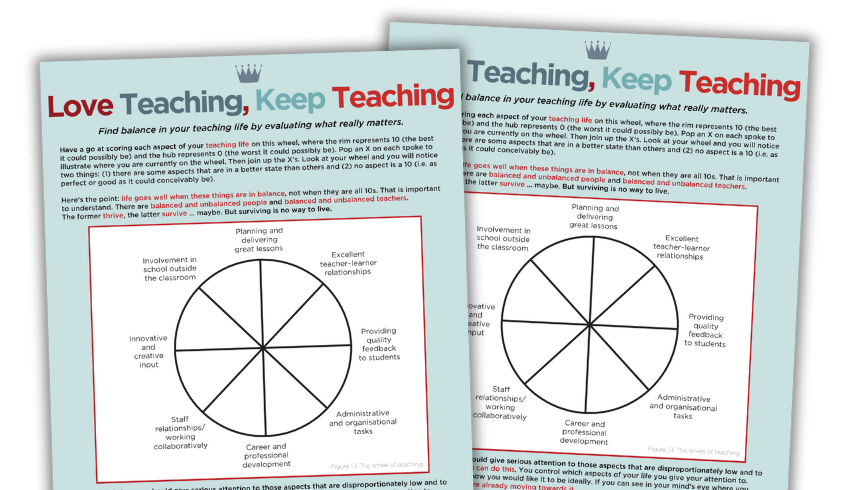
This free ‘Wheel of Teaching’ self-evaluation tool from Love Teaching, Keep Teaching by Peter Radford is designed to support teachers in reflecting on different areas of their professional life and restoring a sense of balance.
Simply having someone in school that you can be honest with about your struggles will give you that voice. After all, it’s reassuring to know that you can ask for support if it’s needed.
“Simply having someone in school that you can be honest with about your struggles will give you that voice”
As a senior leader, when you have return-to-work discussions with colleagues about potential mental health issues, it’s important that you conduct these in a way that encourages honesty and respect, and demonstrates genuine support.
If you manage them badly, they could cause further staff absence. And in the worst case, this could constitute a form of discrimination.
Undivided attention
Colleagues with diagnosed mental health conditions are protected by The Equality Act 2010. As such, they:
- cannot be discriminated against
- are entitled to ‘reasonable adjustments’
- cannot be dismissed or selected for redundancy due to their condition
You should have conversations about mental health in an undisturbed, private location. This needs to be at a time where neither of you will feel rushed. It also needs to be somewhere you are unlikely to be interrupted. After all, you might be discussing highly sensitive personal information.
Leave your phone ‘off the hook’ and keep mobile devices out of reach. This is important, as your colleague may be feeling quite low. This might be to the point where they consider themselves to be an inconvenience to others.
The fact that you are giving them your undivided attention will be hugely significant for them. The conversation may mark the first time they have ever opened up to someone else about their feelings and mental ill health.
“The fact that you are giving them your undivided attention will be hugely significant for them”
Alternatively, your colleague may prefer to discuss their mental health away from the school site. This could be a good way for them to see that you genuinely care about them. This is rather than simply having the conversation with them because you have to as part of your job.
Signposting
If your colleague is struggling to accept that they are experiencing a period of poor mental health, it may be a good idea to prepare some concrete examples in advance. Discussing these could lead to a dialogue about the causes of the colleague’s behaviour.
They need to know that you are there to help, and can signpost them to further resources and support services, if needed.
- This list from the Mental Health Foundation of services and organisations that offer help and support directly to people with mental health problems
- Expert mental health training from MHFA England
Cultural change
Colleagues may get emotional when opening up and discussing their mental health. You need to feel comfortable with this. The person in question may wish to have some time to sit quietly with a cup of tea and a tissue after.
It is important that you don’t allow the colleague to leave the conversation feeling distressed. You should also check in with them before they leave the building at the end of the day.
They may feel embarrassed, but knowing that they can return to school the next day feeling heard, valued and understood will make a huge difference.
Remember that it takes time to embed a cultural change with regards to mental health within a school.
Looking after your own mental health
You also need to feel comfortable talking about how you are looking after their own mental health. Be ready to show that you have a life outside of school.
Senior leaders are role models for other staff members, and it should be acceptable for you to have hobbies, attend exercise classes, join choir practices or whatever else makes you smile at the end of a busy day.
“Be ready to show that you have a life outside of school”
No one aspires to be the kind of school leader who behaves like an automaton, handing out insincere ‘wellbeing’ ideas just to tick a box.
You need to give all staff training to make sure they know how to look after their own mental health. And staff need to feel that they will always have someone in school they can talk to if they are struggling.
Warning signs of mental ill health
Train all leaders (and ideally staff) in identifying the signs and symptoms that can be indicators of mental ill health. These might include physical signs, such as:
- Stomach problems
- Frequent minor illnesses, such as colds
- Headaches
- Weight loss or gain
- Extreme tiredness
- Frequent tearfulness
- Increased consumption of caffeine, alcohol or cigarettes
However, a range of behavioural changes may also occur, including:
- Failure to meet deadlines
- Complaints about workload
- Irritability with colleagues
- Inability to concentrate
- Difficulty with memory
- Taking on extra projects
- Withdrawal
- Loss of confidence
First-hand experiences

- Find out how Castle Academy’s mental health programme has helped light up pupils’ futures
Teacher accounts
They can be tough to read, but sometimes getting someone’s own words on mental health and wellbeing issues can be the best way to fully comprehend your own or others’ experiences, so give these pieces a read.
- “I collapsed on the driveway and sobbed” – Ian Eagleton on how he changed how he worked to never feel like this again
- “I found myself crying for no reason” – Kayleigh Marsden explains how being open about her mental health stopped her from leaving the profession she loves
- What to do when you’re bullied at work – Mary Thornton and Pat Bricheno discuss how while it can feel like there’s nowhere to turn, that keeping your head down is often the worst thing to do
- “The school I taught in was a toxic work environment” – An anonymous teacher shares her experiences of working in a toxic environment and offers advice for those who find themselves in the same position
- “I was bullied by my headteacher for years” – An anonymous teacher had to work in a toxic culture in one school, but was determined not to be pushed out







